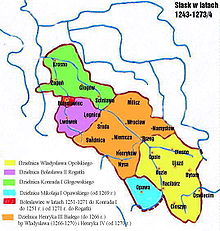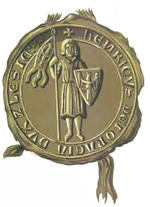Henry III. (Silesia)
Henry III. Called the White ( Polish Henryk III Biały. * 1227 / 1230 ; † 3. December 1266 ) came from the dynasty of the Silesian Piast dynasty . From 1248 until his death he was Duke of Silesia - Breslau .
Life

Henry III. was born between 1227 and 1230 as the second eldest son Heinrich II of Silesia and his wife Anna of Bohemia , the daughter of the Bohemian king Ottokar I. Přemysl . His father, who ruled over Silesia , Krakow and Greater Poland , was killed in the battle of Wahlstatt in 1241 in the battle against the Mongols, near today's Wahlstatt monastery . Henry III. was at most 14 years old at the time and therefore still underage. In contrast, his older brother Boleslaus succeeded his father and ruled Lower Silesia . In 1242 his brother Mieszko , who had ruled Lebus for a year, died surprisingly . Since then, Heinrich III. Co-regent of his brother Boleslaus.
He was not considered of legal age until 1247, but his brother denied him his claim to power. It was only with the help of the nobility that Heinrich Boleslaus managed to give in and forced his co-regency on him. This connection was accompanied by quarrels, so a year later he implemented a partition of Lower Silesia and it was stipulated that both had to rule with co-regents. Heinrich received the more valuable area around Central Silesia and ruled with his brother Wladislaw . Its new territory extended to the cities of Militsch and Namslau in the north, as well as Neisse and Schweidnitz in the south. Boleslaus now received the western part of Lower Silesia, the Duchy of Liegnitz , but had disputes with his co-regent, his brother Konrad II . This continued the fragmentation of Silesia into small dominions. The Silesian nobility naturally supported this policy, as they were concerned with a weakening of the duchy and a certain autonomy.
For Boleslaus this enormous loss of power was irresponsible and a war was foreseeable. But he was in need of money, so he sold half of the Lebus region to Wilbrand von Käfernburg , the Archbishop of Magdeburg . In contrast to his brother, Heinrich was considered peaceful and thrifty, so for the time being it was only a matter of upgrading. Finally, however, in 1250 Konrad intervened by demanding a separate part of the country and even asserting his claim on Breslau. He even succeeded in removing Heinrich for three years. But then the whole Duchy of Liegnitz broke up and through this power vacuum Heinrich managed to reign without arms.
Alliance with Bohemia
In the following years Heinrich became the most important Duke of Silesia. After he had consolidated his power internally, he could now take care of his relations with foreign countries. He maintained good contacts with the Bohemians , which ultimately led to support from Bohemia and an alliance. However, this alliance brought with it new enemies. In 1253 Přemysl Ottokar II became the new King of Bohemia, who, because of his wealth, had a good chance of receiving the Roman-German imperial title . Now it came to war with the Hungarian Árpádenkönig Béla IV. As an ally of Bohemia, Silesia was visited several times by the Polish armies allied with Hungary until 1254. Heinrich remained loyal to the King of Bohemia and took part with him in the Battle of Kressenbrunn in 1260 . Here, too, it became apparent that the neighbors always preferred him to his brother, and the Margraves of Meissen also supported him . Like his predecessors, he strove as a duke to rule over senior citizenship in Poland , but his territory was only a rump state and because of its size and the unclear border location he lacked the necessary domestic power to enable this plan to be seriously tackled.
Domestic politics
However, one of his merits is that, like his predecessors, he continued to bring German settlers into his country in the course of the colonization in the east and thus made progress on a political, cultural and, above all, economic level. During his reign there were numerous urban uprisings , especially Wroclaw finally achieved the metropolitan position, which was to continue later. The year 1261 is particularly noteworthy here, because on December 16, he and his brother Wladislaw granted it Magdeburg city charter, thereby ensuring a planned and generous reconstruction of the city after the Mongol storm.
Nobility revolt and early death
Nevertheless, he aroused the displeasure of the nobility, because after the division of the Duchy of Liegnitz he prohibited them from appropriating the freed goods and wanted to limit their power. All this led to an uprising of the nobility in 1266, which was not inconvenient, especially for the Breslau bishop Thomas I and Duke Boleslaus, as this had to lead to an increase in power for them. Especially since it was demanded that the Duchy of Breslau be divided between Heinrich and his youngest brother Wladislaw, Archbishop of Salzburg since 1265. The uprising failed because the nobility did not succeed in achieving their goals, but in the same year the conspirators achieved partial success. Because on December 3rd of the same year Heinrich died unexpectedly, at the age of 39 years or less. It is controversial what caused his death so early, it is believed that he was poisoned like some of his predecessors. Such an act could have come from the aristocracy in particular, since Heinrich had certainly cracked down on those responsible after the failure of the uprising. Boleslaus and Thomas may also have been involved in a murder. In any case, a reason for death is carved on his tomb in the Ursuline Church in Breslau:
"Anno domini Millesimo, Nonas Decembris obiit veneno inclitus dux Wratislaviensis Henricus tertius, secundus filius secundi Henrici, a Thartaris"
"In the year of the Lord 1266, on December 9th, the well-known Breslau Duke Heinrich III, the second son of Heinrich II, died from poisoning."
He was succeeded by his brother Wladislaw (until 1270), followed by Heinrich's son Heinrich IV. In the period that followed, central power in Silesia lost more and more importance, as the individual states were even further fragmented.
children
Heinrich married Judith († 1257/65), widow of Opole Duke Mieszko II , on June 8, 1252. The children were from the marriage:
- Hedwig (* 1252/56; † before December 14, 1300), married in 1271/1272 to Heinrich Landgrave of Thuringia . After his death, she married Otto Graf von Anhalt for the second time in 1283
- Henry IV († 1290)
In the year of his death in 1266, Heinrich married Helene, daughter of Duke Albrecht I of Saxony , and the marriage remained childless.
ancestors
| Agnes of Antioch daughter of Rainald de Chatillon |
Béla III. (1148–1196) |
Judith of Thuringia (after 1135–1174), Landgrave of Thuringia and Queen of Bohemia |
Vladislav II (around 1110–1174), King of Bohemia |
Agnes von Wettin († 1195) |
Berthold III. von Andechs-Meran († 1204), Count of Tyrol, Carinthia and Istria |
Christine († 1204/1208), from a Central German count family |
Boleslaus I (1127–1201), the Tall One , Duke of Silesia |
||||||||||||||||||||||||||||||||||||||||||||||||||||||
|
Constance of Hungary (around 1177–1240), Queen of Bohemia |
Ottokar I. Přemysl (around 1155–1230), King of Bohemia |
Hedwig von Andechs (1174-1243), Duchess of Silesia (canonized in 1267) |
Henry I (1163–1238), the bearded , Duke of Silesia |
||||||||||||||||||||||||||||||||||||||||||||||||||||||||||
|
Anna of Bohemia (1201–1265) |
Heinrich II. (1196 / 1207–1241), the pious , Duke of Silesia, Cracow and Greater Poland |
||||||||||||||||||||||||||||||||||||||||||||||||||||||||||||
|
Henry III. (1227 / 1230–1266), Duke of Silesia-Breslau |
|||||||||||||||||||||||||||||||||||||||||||||||||||||||||||||
literature
- Heinrich Appelt : Heinrich III., Duke of Silesia. In: New German Biography (NDB). Volume 8, Duncker & Humblot, Berlin 1969, ISBN 3-428-00189-3 , p. 394 ( digitized version ).
- Colmar Grünhagen : Heinrich III., Duke of Silesia (Breslau) . In: Allgemeine Deutsche Biographie (ADB). Volume 11, Duncker & Humblot, Leipzig 1880, p. 606 f.
Web links
| personal data | |
|---|---|
| SURNAME | Henry III. |
| ALTERNATIVE NAMES | Henry the White; Henryk III. Biały (Polish) |
| BRIEF DESCRIPTION | Duke of Silesia-Wroclaw |
| DATE OF BIRTH | between 1227 and 1230 |
| DATE OF DEATH | December 3, 1266 |
